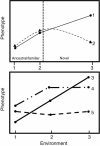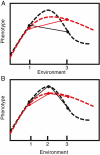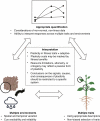Characterization, costs, cues and future perspectives of phenotypic plasticity
- PMID: 35771883
- PMCID: PMC9445595
- DOI: 10.1093/aob/mcac087
Characterization, costs, cues and future perspectives of phenotypic plasticity
Abstract
Background: Plastic responses of plants to the environment are ubiquitous. Phenotypic plasticity occurs in many forms and at many biological scales, and its adaptive value depends on the specific environment and interactions with other plant traits and organisms. Even though plasticity is the norm rather than the exception, its complex nature has been a challenge in characterizing the expression of plasticity, its adaptive value for fitness and the environmental cues that regulate its expression.
Scope: This review discusses the characterization and costs of plasticity and approaches, considerations, and promising research directions in studying plasticity. Phenotypic plasticity is genetically controlled and heritable; however, little is known about how organisms perceive, interpret and respond to environmental cues, and the genes and pathways associated with plasticity. Not every genotype is plastic for every trait, and plasticity is not infinite, suggesting trade-offs, costs and limits to expression of plasticity. The timing, specificity and duration of plasticity are critical to their adaptive value for plant fitness.
Conclusions: There are many research opportunities to advance our understanding of plant phenotypic plasticity. New methodology and technological breakthroughs enable the study of phenotypic responses across biological scales and in multiple environments. Understanding the mechanisms of plasticity and how the expression of specific phenotypes influences fitness in many environmental ranges would benefit many areas of plant science ranging from basic research to applied breeding for crop improvement.
Keywords: Phenotypic plasticity; environmental cues; genotype x environment interaction; phenotypic variation.
© The Author(s) 2022. Published by Oxford University Press on behalf of the Annals of Botany Company.
Figures




Similar articles
-
Constraints on the evolution of adaptive phenotypic plasticity in plants.New Phytol. 2005 Apr;166(1):49-60. doi: 10.1111/j.1469-8137.2004.01296.x. New Phytol. 2005. PMID: 15760350 Review.
-
Ecological limits to plant phenotypic plasticity.New Phytol. 2007;176(4):749-763. doi: 10.1111/j.1469-8137.2007.02275.x. New Phytol. 2007. PMID: 17997761 Review.
-
The impact of beneficial plant-associated microbes on plant phenotypic plasticity.J Chem Ecol. 2013 Jul;39(7):826-39. doi: 10.1007/s10886-013-0326-8. Epub 2013 Jul 27. J Chem Ecol. 2013. PMID: 23892542 Free PMC article. Review.
-
Constraints on the evolution of phenotypic plasticity: limits and costs of phenotype and plasticity.Heredity (Edinb). 2015 Oct;115(4):293-301. doi: 10.1038/hdy.2015.8. Epub 2015 Feb 18. Heredity (Edinb). 2015. PMID: 25690179 Free PMC article. Review.
-
Why study plasticity in multiple traits? New hypotheses for how phenotypically plastic traits interact during development and selection.Evolution. 2022 May;76(5):858-869. doi: 10.1111/evo.14464. Epub 2022 Mar 20. Evolution. 2022. PMID: 35274745 Free PMC article.
Cited by
-
Weaker selection on genes with treatment-specific expression consistent with a limit on plasticity evolution in Arabidopsis thaliana.Genetics. 2023 May 26;224(2):iyad074. doi: 10.1093/genetics/iyad074. Genetics. 2023. PMID: 37094602 Free PMC article.
-
Exploring the complex information processes underlying plant behavior.Plant Signal Behav. 2024 Dec 31;19(1):2411913. doi: 10.1080/15592324.2024.2411913. Epub 2024 Oct 9. Plant Signal Behav. 2024. PMID: 39381978 Free PMC article. Review.
-
Selection maintains a nonadaptive floral polyphenism.Evol Lett. 2024 Apr 25;8(4):610-621. doi: 10.1093/evlett/qrae017. eCollection 2024 Aug. Evol Lett. 2024. PMID: 39100232 Free PMC article.
-
Local adaptation to climate inferred from intraspecific variation in plant functional traits along a latitudinal gradient.Conserv Physiol. 2024 May 5;12(1):coae018. doi: 10.1093/conphys/coae018. eCollection 2024. Conserv Physiol. 2024. PMID: 38715928 Free PMC article.
-
Phenotypic Variation of Oak Species (Quercus spp.) Reveals Adaptive Strategies Across Natural and Semi-Artificial Oak Stands.Ecol Evol. 2025 Jun 16;15(6):e71217. doi: 10.1002/ece3.71217. eCollection 2025 Jun. Ecol Evol. 2025. PMID: 40524777 Free PMC article.
References
-
- Agrawal AA, Conner JK, Johnson MTJ, Wallsgrove R.. 2002. Ecological genetics of an induced plant defense against herbivores: additive genetic variance and costs of phenotypic plasticity. Evolution 56: 2206–2213. - PubMed
-
- Van Alstyne KL. 1988. Herbivore grazing increases polyphenolic defenses in the intertidal brown alga Fucus distichus. Ecology 69: 655–663.
-
- Anderson JT. 2016. Plant fitness in a rapidly changing world. New Phytologist 210: 81–87. - PubMed
-
- Arnold PA, Kruuk LEB, Nicotra AB.. 2019a. How to analyse plant phenotypic plasticity in response to a changing climate. New Phytologist 222: 1235–1241. - PubMed
Publication types
MeSH terms
LinkOut - more resources
Full Text Sources

